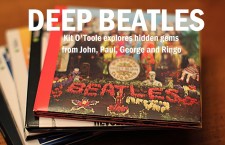A cacophony of guitars, brass, furious drums, John Lennon’s lead vocal, and even animal noises, “Good Morning Good Morning” may stand as one of Lennon’s most eccentric compositions. Yet its tale of suburban banality, contrasted with some blistering lead guitar, ranks as one of the standout Sgt. Pepper’s Lonely Hearts Club Band tracks. A deconstruction of the track reveals its underlying meaning and stunning components, most notably Ringo Starr’s complicated drumming.
Inspiration can come from unlikely places, and “Good Morning Good Morning” exemplifies this notion. While sitting at the piano and brainstorming song ideas in 1967, Lennon often had the television flickering in the background. An advertisement for Corn Flakes cereal aired, featuring the following jingle:
Good morning, good morning
The best to you each morning.
Sunshine breakfast, Kellogg’s Corn Flakes
Crisp and full of fun.
The song’s opening words appealed to Lennon, and he quickly penned the lyrics in his Kenwood home. In a 1968 interview, he stated that the words partially referred to growing up in Liverpool. “But it was writing about my past so it does get the kids because it was me at school, my whole bit,” he said. As usual, he later dismissed the lyrics as “a bit of gobbledygook, but nice words” in 1972. In his biography Many Years from Now, Paul McCartney claimed that the words reflected Lennon’s disintegrating marriage, that the singer felt trapped by his humdrum suburban life.
His home demo contains most of the final verses, although the tempo resembles a ticking clock.
Lennon brought the track to Abbey Road Studios on February 8, 1967, and work progressed quickly. In eight takes, the Beatles laid down the rhythm track complete with drums, tambourine, rhythm guitar, and Lennon’s guide vocal. On February 16, the group resumed work on take eight of “Good Morning Good Morning,” with McCartney adding his bass part while Lennon contributed his lead vocal. At this point, McCartney and George Harrison also contributed backing harmonies. Anthology 3 includes this overdubbed version of take eight’s backing track.
The Beatles, George Martin, and engineer Geoff Emerick did not return to the song for almost a month. By March 13, Lennon decided it needed a brass section for a punchier sound. They recruited members of Sounds Incorporated, a band that had previously toured with the Beatles. A largely instrumental group that also backed Gene Vincent and Little Richard in Europe, they briefly served as members of Brian Epstein’s stable of artists. The six-hour session added trombones, saxophones and a French Horn to the mix. In Mark Lewisohn’s The Complete Beatles Recording Sessions, second engineer Richard Lush remembered “flanging, limiting and compressing it, anything to make it sound unlike brass playing it was typical John Lennon—he just wanted it to sound weird.”
Two weeks later, Lennon added a second lead vocal, harmonizing with himself at times, and Lennon and McCartney overdubbed additional backing vocals. Then McCartney contributed his blistering guitar solo (Lennon and Harrison played rhythm guitars on the track), and they assembled the animal-sound effects from the Abbey Road archives. Final touches included harmonica courtesy of Harrison, Starr, Mal Evans, and Neil Aspinall, as well as an organ part played by Lennon. The last overdubs, including the tacking on of sound effects, occurred on March 29 and 31.
Singing in a flat, almost sarcastic tone, Lennon narrates the day of an average man. He trudges to work, clearly hating his job, but finds no relief once he leaves for home. Aimlessly wandering the streets, he finds emptiness: “Everybody knows there’s nothing doing; everything is closed it’s like a ruin; everyone you see is half asleep,” he chants, painting a bleak picture of suburbia. Believing that revisiting his youth might cure his ennui, he visits his old school: “Nothing has changed it’s still the same,” he concludes. Finally the lead character tries to find life in flirting with local girls while married men go home for “tea and meet the wife” (also the title of a popular British soap opera). Ultimately, he has “nothing to say but it’s OK,” again stressing the boredom in this workaday world. By repeating the title phrase ad infinitum, the song suggests this never ending cycle of tedium.
In addition to Lennon’s biting lyrics, the instrumentation establishes this sense of irony and frustration, a circus-like atmosphere minus excitement and joy. A key component to “Good Morning Good Morning” is Starr’s skillful drumming, made more impressive by the constant time changes. Anyone who doubts Starr’s musicianship need only listen to the isolated drum track.
Elsewhere, McCartney’s bass and lead guitar enhance the percussion and underscore Lennon’s sharp vocals. Lennon and Harrison’s rhythm guitars play in tandem with Starr’s drumming, the distortion giving them a grungier sound. Listen for the Indian influence on McCartney’s solo:
Finally, note the isolated vocals — Lennon’s snarling voice contrasts with the tight harmonies. Injecting some humor, the Beatles gradually transition from chanting “good morning” to the German phrase “guten morgan.”
“Good Morning Good Morning” works due to the sum of its parts. Lennon’s satirical words still sting, while Starr’s hard-driving drumming accentuates their bite. Add rhythm guitars, bass, lead guitar, and brass, and what results is a seemingly straightforward, upbeat rock track that tells a bleak story of discontentment.
- How John Lennon Came Roaring Back on the Beatles’ White Album - November 22, 2023
- Five ‘With the Beatles’ Deep Cuts That Illustrate Their Lasting Debt to R&B - November 20, 2023
- Five Must-Hear Deep Cuts from the Beatles’ ‘Past Masters’ - March 7, 2023


